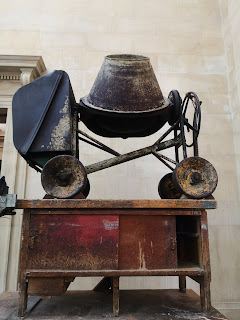Mike Nelson's The Asset Strippers is Tate Britain's 2019 commission and the views of both the aforementioned imaginary cynic and ponce would be equally valid. On one hand, Nelson has, quite literally, just filled the gallery spaces with loads of old, often rusty and antiquated, materials from the building trade but, equally, that doesn't mean it's not a reasonably enjoyable experience to have a nose around it.
It reminded me of going to my Grandad's house and him taking me out to the shed to mend a puncture on my bike or something. There would be saws, spanners, wrenches, pliers, hammers, and tools I couldn't even name lying around. All cluttering up oily surfaces and hanging from the walls, all darkly coloured or at least with their chrome surfaces obscured by a thick layer of grime, and all hanging up in a dimly lit, not particularly pleasant smelling, space.
It was the old days. For the most part it wouldn't have been a space that women would rarely have ventured into and, thus, smells and sights were permitted that may have been subject to, at the very least, a blast of Febreze elsewhere in the house. But it was fascinating and, to me, was almost like going into an art gallery. Which was something I certainly didn't do much of as a child.
All these remarkable things that I didn't really understand but one day surely would. I just needed to be inducted into the ways of the grown up. That never really happened and, to this day, the main skill I have with my hands is typing and lifting drinks to my mouth.
For the shame! The reasoning behind this display of anvils, cement mixers, weighing machines, pallet trucks, gates, and chains goes something like this. The Duveen Galleries were originally designed to be the first purpose built sculpture galleries in all England, intended to rival the ancient sculpture courts at the V&A, and, as if in response to the V&A's collection of Tuscan plaster casts, models of martyr's tombs, and replicas of Roman columns, Nelson (and there's a name that suggests knowledge of columns and sculpture) is displaying monuments from another, more recent, bygone age.
It's quite a nifty trick really. These tools informed the post-war landscape of my generation so, on a very basic level, they can't help but evoke nostalgic thoughts (although perhaps not as strongly as a blast of Altered Images or The Human League) but, on top of that, it's worth documenting these things. This is history. This is our history.
The title Nelson has given his show, The Asset Strippers, refers to how he came into possession of these objects. Via salvage yards and online auctions of company liquidators. Which gives the show a political dimension and has things to say about the changing nature of Britain's role in the world and, on a larger scale, the changing nature of work.
What things it has to say is unclear. That's how it seems to work with art! Here's what Nelson himself says about the exhibition:- "Manipulation and arrangement subtly shift them from what they once were into sculpture, and then back again to what they are - examples of the machines and equipment left over from industry and infrastructure. The exhibition weaves this allusion with that of British history. It presents us with a vision of artefacts cannibalised from the last days of the industrial era in place of the treasures of empire that would normally adorn such halls".
Well, that sure sounds, on the surface, a lot of hoity-toity, hi-falutin, talk you got there fella! But, again, that is the approach of the cynic. What Nelson has to say actually makes a lot of sense. Pallets, tyres, and other assorted 'components' (often tucked away in splintery looking wooden drawers daubed with painted numbers) say as much, if not more, about us as plaster casts of Milanese window frames, reliefs of The Nymph of Fontainebleau, or effigies of Berengaria of Navarre. Grandad Evans, it must be said, did not have a model of Trajan's Column in his shed.
You can pass through the exhibition pretty quickly. There's not a great deal to read and there would be no need for that anyway. It's, for those my age, a trip down memory lane - an almost Proustian one. For younger visitors, a demographic that is increasing at a rapid and worrying rate, some of this stuff may look almost alien. For them, hopefully, it's an education. A window into a world that had mostly disappeared before they came of age.
Although I finally learnt how to fix my own punctures I never did become particularly handy with tools and have never even so much as owned a tool belt or even my own personal anvil. I've got some screwdrivers, some masking tape, some taps and valves, and I'm sure there's an adjustable spanner lying about somewhere but to own a concrete mixer or my own personal pallet truck would I'm sure be the cause of great pride.
In lieu of such treasures I'm grateful to Mike Nelson and Tate Britain for sending me back to a time when I'd ride my Grifter across The Green to my Grandad's house, push my grubby face up against his window (smeared with the residue of recently consumed Curly Wurly and Texan bars no doubt) and lovingly watch my Grandad pass an inner tube slowly through a bucket of water until bubbles appeared before going inside and Granny making me a lovely Welsh rarebit.
I'm not sure I totally understood the poliltics of Mike Nelson's installation but, as you'll have gathered, I certainly enjoyed basking in that warm glow of nostalgia. It's a nice place to visit but don't live there - and don't vote to go back there!


























No comments:
Post a Comment